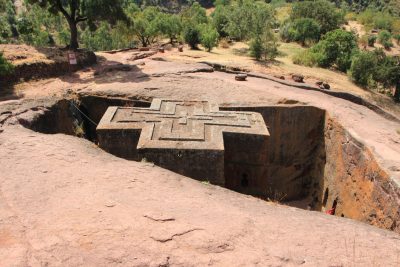Kingdoms and Monuments: St. George’s Church (Ethiopia)

Named the 8th wonder of the world, each of the Churches at Lalibela is hewn out of a single stone (Ludo Van Den Nouweland, Pexels)
Biete Giyorgis (Church of St. George): Ethiopia’s Timeless Rock-Hewn Wonder
Carved from solid stone, Biete Giyorgis (the Church of Saint George) is a masterpiece of faith and craftsmanship. Sitting high up in the Ethiopian highlands, this church is unlike any other. Shaped like a perfect cross, Biete Giyorgis rises from the earth as if born from the land itself.
Located in Lalibela, a holy city in northern Ethiopia, Biete Giyorgis is one of eleven medieval churches carved directly into the ground. These churches are not built. They are chiseled from the mountain itself.
A Sacred Vision Comes to Life
The story of Biete Giyorgis begins with a king and a vision. In the 12th century, King Gebre Mesqel Lalibela of the Zagwe dynasty received a divine message. He was told to build a “New Jerusalem” in Ethiopia.
Saint George, a revered Christian saint, delivered the message in a vision. In response, the king ordered the creation of these rock-hewn churches. Biete Giyorgis was the last to be built, and the most beautiful.
The church is carved entirely from volcanic rock. Its structure measures 25 meters by 25 meters, and it descends 30 meters deep into the earth. From an aerial view, it appears to be a giant cross that has been planted carefully into the ground. A narrow trench surrounds the church, and a small baptismal pool sits nearby.
The Eleven Churches of Lalibela
Biete Giyorgis is part of a group of eleven churches that were all carved between the late 12th and early 13th centuries. They are grouped into two clusters. A narrow stream called the River Jordan runs between them.
North of the Jordan:
-
Biete Medhani Alem (House of the Savior of the World)
-
Biete Mariam (House of Mary)
-
Biete Maskal (House of the Cross)
-
Biete Denagel (House of the Virgins)
-
Biete Golgotha Mikael (House of Golgotha Mikael)
South of the Jordan:
-
Biete Amanuel (House of Emmanuel)
-
Biete Qeddus Mercoreus (House of St. Mercoreos)
-
Biete Abba Libanos (House of Abbot Libanos)
-
Biete Gabriel-Raphael (House of Gabriel and Raphael)
-
Biete Lehem (House of Holy Bread)
Biete Giyorgis, the eleventh church, stands alone to the west. It is separate, yet connected to the others by a series of trenches and tunnels.
Each church represents a holy place from the Bible. Together, they mirror the sacred landscape of Jerusalem. They include symbolic versions of the Tomb of Christ, Bethlehem, and Golgotha. This was King Lalibela’s gift to Ethiopian Christians who are unable to travel to the Holy Land.
A Living World Heritage Site
In 1978, UNESCO declared the Lalibela churches a World Heritage Site. These churches are still used today. They are not just historic, they are considered holy.
Monks, priests, and pilgrims gather here daily. Worshippers chant ancient hymns. Incense drifts through the air. Prayers echo off stone walls. Many people visit during religious festivals, especially Genna, the Ethiopian Christmas.
The largest of the eleven churches is Biete Medhani Alem. It has five grand aisles and is believed to be the largest monolithic church in the world. But it is Bete Giyorgis, with its cross shape and perfect proportions, that most people remember.
Spiritual and Artistic Beauty
Inside the churches, visitors find murals, frescoes, crosses, and sacred texts. Many walls are covered in paintings of saints and biblical scenes. The interiors are dimly lit, but filled with peace and reverence.
The craftsmanship is astonishing. Remember, all these churches were carved by hand. Workers used simple tools, hammers, and chisels to shape stone into worship spaces.
The churches were made from the top down. Builders started at the surface and carved downward. They created walls, roofs, and columns all from the same rock.
Challenges and Conservation
For centuries, many churches were buried under dirt, plants, and water. Their drainage systems were clogged, and water caused serious damage. Earthquakes and weather have also taken a toll.
In the 20th century, the churches were rediscovered and cleaned. Yet, the challenges remain. Many churches are now in fragile condition. Conservation efforts are ongoing. Experts from Ethiopia and around the world are working to protect them.
Biete Giyorgis has survived better than most. Nonetheless, it is also at risk from erosion and human impact. Responsible tourism and continued restoration are crucial.
The Soul of Ethiopian Christianity
Lalibela is more than a city. It is a spiritual center. Located in Ethiopia’s Amhara Region, it sits in the mountains, surrounded by small villages and stunning landscapes.
The churches are not tourist attractions, they are living spaces of worship. Ethiopian Orthodox Christians come here on pilgrimage. Many walk long distances to reach the site, each carrying their faith on their feet and backs.
The spiritual energy is real. Visitors describe the area as peaceful, timeless, and sacred.
Why Biete Giyorgis Still Matters
Biete Giyorgis is not just a building. It is a symbol. It shows the power of vision, devotion, and African creativity. It reminds the world that Africa has long been constructing architectural wonders.
This church proves that ancient Ethiopia was a center of Christian faith and stone architecture. It was a land of kings, artisans, and spiritual seekers. Today, Biete Giyorgis still stands. It still inspires.
Its walls have seen 900 years of worship. Its cross-shaped shadow still touches the earth. It still calls the faithful and the curious to witness its beauty.
Plan Your Visit to Lalibela
If you want to experience something truly unique, visit Lalibela. Stand beside Biete Giyorgis. Walk its stone paths. Feel the spirit of a place where heaven meets earth.
You don’t need to be religious to be moved. You only need to be human.
Watch this story on 60 Minutes. More @ Rock-Hewn Churches, Lalibela. Read about more Monuments
